Microsoft AZ-102 Exam Practice Questions (P. 3)
- Full Access (76 questions)
- Six months of Premium Access
- Access to one million comments
- Seamless ChatGPT Integration
- Ability to download PDF files
- Anki Flashcard files for revision
- No Captcha & No AdSense
- Advanced Exam Configuration
Question #11
DRAG DROP -
You create a new replication policy in Azure for the physical servers.
You successfully complete the following actions:
✑ Create and configure a Recovery Services vault.
✑ Ensure Internet connectivity.
✑ Ensure that the required URLs are reachable.
✑ Ensure that the host server requirements are met.
✑ Ensure that the servers marked for replication comply with the requirements of the Azure virtual machines.
You need to replicate the on-premises servers to Azure.
Which four actions should you perform in sequence? To answer, move the appropriate actions from the list of actions to the answer area and arrange them in the correct order.
NOTE: More than one order of answer choices is correct. You will receive credit for any of the correct orders you select.
Select and Place:
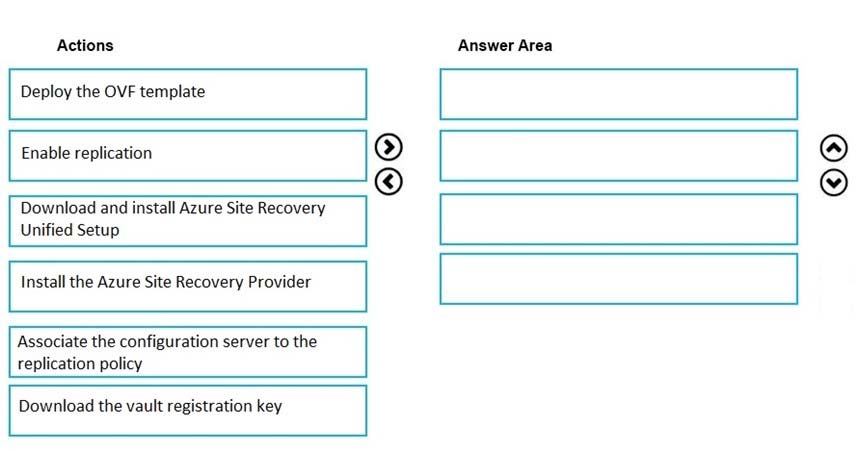
You create a new replication policy in Azure for the physical servers.
You successfully complete the following actions:
✑ Create and configure a Recovery Services vault.
✑ Ensure Internet connectivity.
✑ Ensure that the required URLs are reachable.
✑ Ensure that the host server requirements are met.
✑ Ensure that the servers marked for replication comply with the requirements of the Azure virtual machines.
You need to replicate the on-premises servers to Azure.
Which four actions should you perform in sequence? To answer, move the appropriate actions from the list of actions to the answer area and arrange them in the correct order.
NOTE: More than one order of answer choices is correct. You will receive credit for any of the correct orders you select.
Select and Place:

Correct Answer:
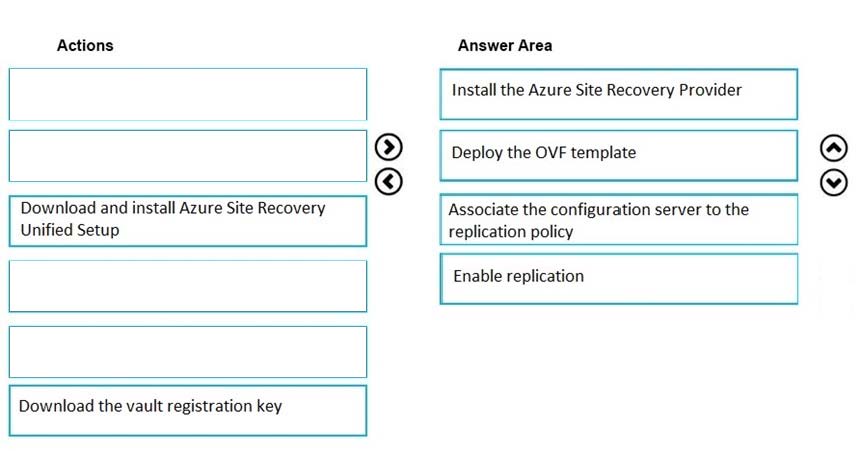
Step 1: Install the Azure Site Recovery Provider
Step 2: Deploy the OVF template -
Set up the source environment.
Download the OVF template for the configuration server, and import the template in VMware.
Note: Open Virtualization Format (OVF) template is an industry standard software distribution model for virtual machine templates. Starting January 2018, configuration server for the VMware to Azure scenario will be available to all our customers as an OVF template.
Step 3: Associate the configuration server to the replication policy
Associate the replication policy with your on-premises configuration server.
Step 4: Enable replication -
References:
https://docs.microsoft.com/en-us/azure/site-recovery/vmware-azure-set-up-replication

Step 1: Install the Azure Site Recovery Provider
Step 2: Deploy the OVF template -
Set up the source environment.
Download the OVF template for the configuration server, and import the template in VMware.
Note: Open Virtualization Format (OVF) template is an industry standard software distribution model for virtual machine templates. Starting January 2018, configuration server for the VMware to Azure scenario will be available to all our customers as an OVF template.
Step 3: Associate the configuration server to the replication policy
Associate the replication policy with your on-premises configuration server.
Step 4: Enable replication -
References:
https://docs.microsoft.com/en-us/azure/site-recovery/vmware-azure-set-up-replication
send
light_mode
delete
Question #12
You plan to move services from your on-premises network to Azure.
You identify several virtual machines that you believe can be hosted in Azure. The virtual machines are shown in the following table.
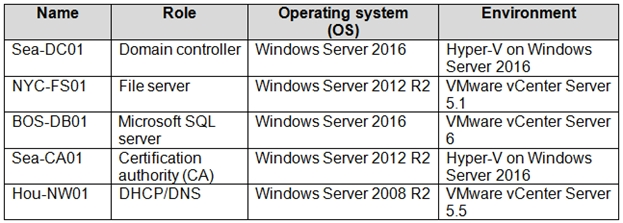
Which two virtual machines can you access by using Azure migrate? Each correct answer presents a complete solution.
NOTE: Each correct selection is worth one point.
You identify several virtual machines that you believe can be hosted in Azure. The virtual machines are shown in the following table.

Which two virtual machines can you access by using Azure migrate? Each correct answer presents a complete solution.
NOTE: Each correct selection is worth one point.
- ASea-CA01
- BHou-NW01
- CNYC-FS01
- DSea-DC01
- EBOS-DB01
Correct Answer:
CE
The VMware VMs must be managed by vCenter Server (version 5.5, 6.0, 6.5 or 6.7).
References:
https://docs.microsoft.com/en-us/azure/migrate/migrate-overview
CE
The VMware VMs must be managed by vCenter Server (version 5.5, 6.0, 6.5 or 6.7).
References:
https://docs.microsoft.com/en-us/azure/migrate/migrate-overview
send
light_mode
delete
Question #13
HOTSPOT -
You have an Azure subscription named Subscription1.
In Subscription1, you create an alert rule named Alert1.
The Alert1 action group is configured as shown in the following exhibit.
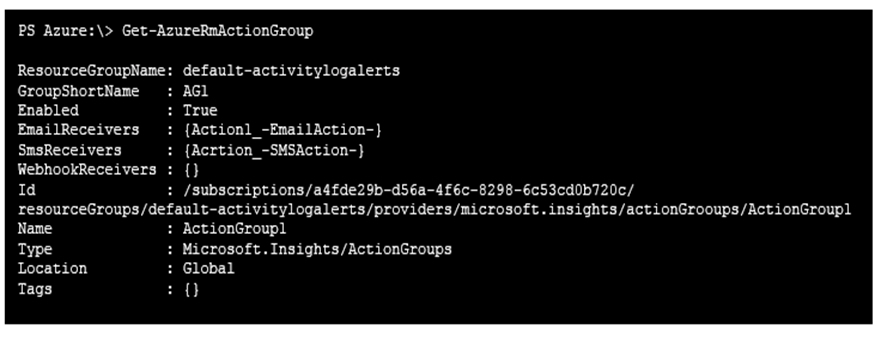
Alert1 alert criteria is triggered every minute.
Use the drop-down menus to select the answer choice that completes each statement based on the information presented in the graphic.
NOTE: Each correct selection is worth one point.
Hot Area:
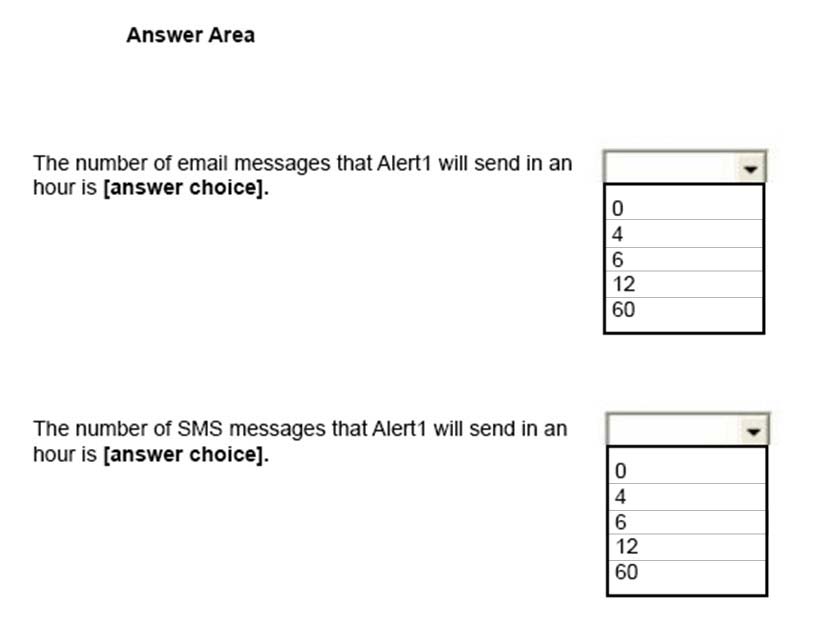
You have an Azure subscription named Subscription1.
In Subscription1, you create an alert rule named Alert1.
The Alert1 action group is configured as shown in the following exhibit.

Alert1 alert criteria is triggered every minute.
Use the drop-down menus to select the answer choice that completes each statement based on the information presented in the graphic.
NOTE: Each correct selection is worth one point.
Hot Area:

Correct Answer:
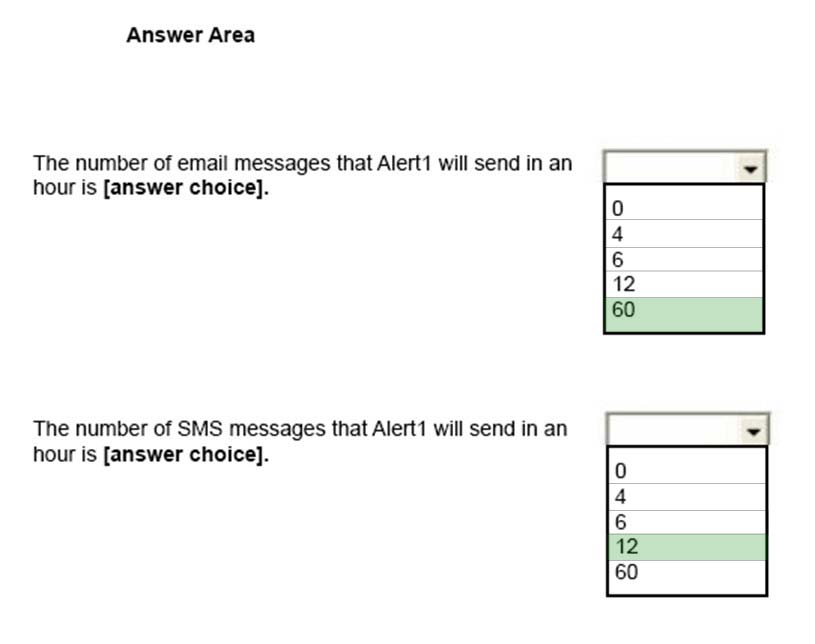
Box 1: 60 -
One alert per minute will trigger one email per minute.
Box 2: 12 -
No more than 1 SMS every 5 minutes can be send, which equals 12 per hour.
Note: Rate limiting is a suspension of notifications that occurs when too many are sent to a particular phone number, email address or device. Rate limiting ensures that alerts are manageable and actionable.
The rate limit thresholds are:
✑ SMS: No more than 1 SMS every 5 minutes.
✑ Voice: No more than 1 Voice call every 5 minutes.
✑ Email: No more than 100 emails in an hour.
✑ Other actions are not rate limited.
References:
https://github.com/MicrosoftDocs/azure-docs/blob/master/articles/monitoring-and-diagnostics/monitoring-overview-alerts.md

Box 1: 60 -
One alert per minute will trigger one email per minute.
Box 2: 12 -
No more than 1 SMS every 5 minutes can be send, which equals 12 per hour.
Note: Rate limiting is a suspension of notifications that occurs when too many are sent to a particular phone number, email address or device. Rate limiting ensures that alerts are manageable and actionable.
The rate limit thresholds are:
✑ SMS: No more than 1 SMS every 5 minutes.
✑ Voice: No more than 1 Voice call every 5 minutes.
✑ Email: No more than 100 emails in an hour.
✑ Other actions are not rate limited.
References:
https://github.com/MicrosoftDocs/azure-docs/blob/master/articles/monitoring-and-diagnostics/monitoring-overview-alerts.md
send
light_mode
delete
Question #14
DRAG DROP -
You have an on-premises file server named Server1 that runs Windows Server 2016.
You have an Azure subscription that contains an Azure file share.
You deploy an Azure File Sync Storage Sync Service, and you create a sync group.
You need to synchronize files from Server1 to Azure.
Which three actions should you perform in sequence? To answer, move the appropriate actions from the list of actions to the answer area and arrange them in the correct order.
Select and Place:
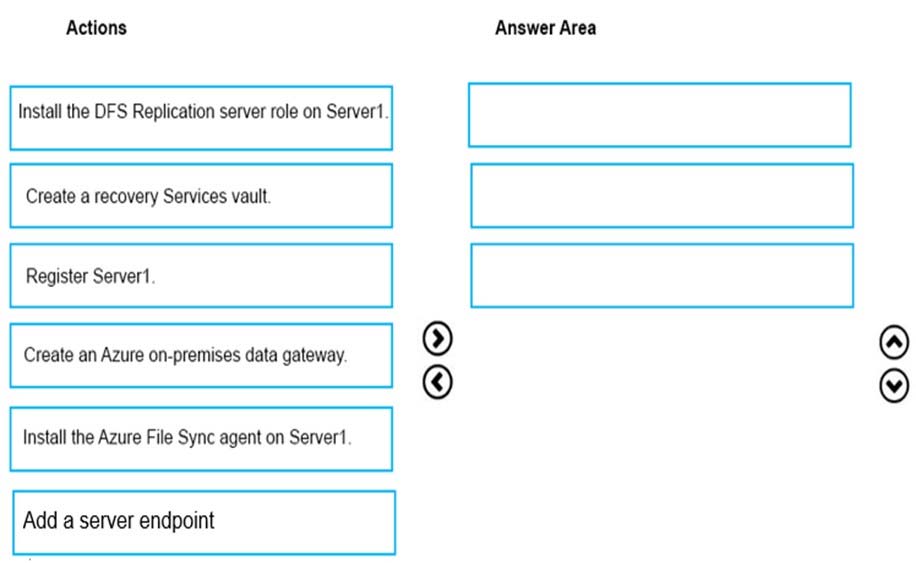
You have an on-premises file server named Server1 that runs Windows Server 2016.
You have an Azure subscription that contains an Azure file share.
You deploy an Azure File Sync Storage Sync Service, and you create a sync group.
You need to synchronize files from Server1 to Azure.
Which three actions should you perform in sequence? To answer, move the appropriate actions from the list of actions to the answer area and arrange them in the correct order.
Select and Place:

Correct Answer:
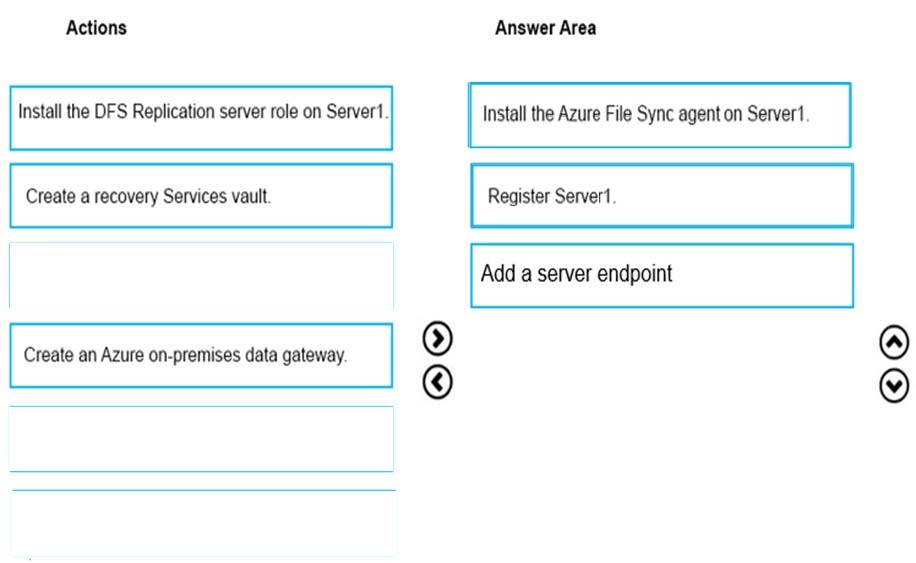
Step 1: Install the Azure File Sync agent on Server1
The Azure File Sync agent is a downloadable package that enables Windows Server to be synced with an Azure file share
Step 2: Register Server1.
Register Windows Server with Storage Sync Service
Registering your Windows Server with a Storage Sync Service establishes a trust relationship between your server (or cluster) and the Storage Sync Service.
Step 3: Add a server endpoint -
Create a sync group and a cloud endpoint.
A sync group defines the sync topology for a set of files. Endpoints within a sync group are kept in sync with each other. A sync group must contain one cloud endpoint, which represents an Azure file share and one or more server endpoints. A server endpoint represents a path on registered server.
References:
https://docs.microsoft.com/en-us/azure/storage/files/storage-sync-files-deployment-guide

Step 1: Install the Azure File Sync agent on Server1
The Azure File Sync agent is a downloadable package that enables Windows Server to be synced with an Azure file share
Step 2: Register Server1.
Register Windows Server with Storage Sync Service
Registering your Windows Server with a Storage Sync Service establishes a trust relationship between your server (or cluster) and the Storage Sync Service.
Step 3: Add a server endpoint -
Create a sync group and a cloud endpoint.
A sync group defines the sync topology for a set of files. Endpoints within a sync group are kept in sync with each other. A sync group must contain one cloud endpoint, which represents an Azure file share and one or more server endpoints. A server endpoint represents a path on registered server.
References:
https://docs.microsoft.com/en-us/azure/storage/files/storage-sync-files-deployment-guide
send
light_mode
delete
Question #15
You are building a custom Azure function app to connect to Azure Event Grid.
You need to ensure that resources are allocated dynamically to the function app. Billing must be based on the executions of the app.
What should you configure when you create the function app?
You need to ensure that resources are allocated dynamically to the function app. Billing must be based on the executions of the app.
What should you configure when you create the function app?
- Athe Windows operating system and the App Service plan hosting plan
- Bthe Docker container and an App Service plan that uses the B1 pricing tier
- Cthe Docker container and an App Service plan that uses the S1 pricing tier
- Dthe Windows operating system and the Consumption plan hosting plan
Correct Answer:
D
Azure Functions runs in two different modes: Consumption plan and Azure App Service plan. The Consumption plan automatically allocates compute power when your code is running. Your app is scaled out when needed to handle load, and scaled down when code is not running.
Incorrect Answers:
A: When you run in an App Service plan, you must manage the scaling of your function app.
References:
https://docs.microsoft.com/en-us/azure/azure-functions/functions-create-first-azure-function
D
Azure Functions runs in two different modes: Consumption plan and Azure App Service plan. The Consumption plan automatically allocates compute power when your code is running. Your app is scaled out when needed to handle load, and scaled down when code is not running.
Incorrect Answers:
A: When you run in an App Service plan, you must manage the scaling of your function app.
References:
https://docs.microsoft.com/en-us/azure/azure-functions/functions-create-first-azure-function
send
light_mode
delete
All Pages
